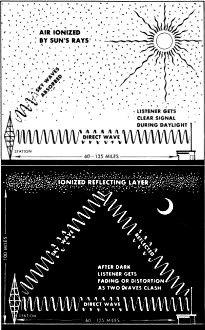Explain Radio Fading to the Public |
|
Explain Radio Fading to the Public  Neither Radio Sets Nor Station to Blame for After-Dark Distortion Beginning this month, Nature will again be giving broadcast listeners extraordinary reception. After nightfall, the whole broadcast spectrum will again be filled with far-off stations, many of them roaring in as strong as "locals." This means that our radio-reflecting-layer, 100 miles up in the sky, is working as an excellent radio mirror again.* But such "good reception," as we enjoy at present, also brings some annoying troubles to broadcast listeners. These are twofold: Two Kinds of Trouble 1. Distant stations come in strong, right alongside familiar local stations, and so cause crosstalk and "monkey chatter" on familiar local channels. 2. Nearby high-power stations (60 to 100 miles away) have their sky waves so strongly reflected by the excellent sky mirror, that their reflected waves (traveling a path 150 miles longer) reach the listener out-of-step with the same station's direct-wave he ordinarily hears. This conflict of the two sets of waves, if of equal strength, may produce annoying total fading. Or, certain audible frequencies may be suppressed, so that at intervals the announcer "sounds as if he had a mouthful of hot mush," and a fine orchestra tinkles like a Chinese band! Too Much of a Good Thing! Broadcast listeners hearing such interference, usually blame their sets. But neither the set nor the broadcast station is at fault! Nor is the set maker, the dealer or the radio repairman! Nature herself is to blame, by temporarily making her reception conditions too good, - so that we suffer from the spillover. Fortunately, the trouble occurs only after dark, and usually for limited periods. Try This Solution A very long antenna, or a pickup from telephone wires will sometimes help at the receiving end. This affords pickup from a number of points, so that fading at anyone point is neutralized. Or the listener can tune to stations less than 60 miles distant, whose reception is unimpaired. He also will find during such distortion periods that he has new and almost unlimited choices among stations over 150 miles away, for on such nights these distant broadcasters, including many never before heard, will be found coming in like locals. "This is to be expected, now that sunspots are at a minimum in their 11-year cycle. for it is the electron projectiles from the sunspots which shatter the radio mirror and so interfere with long-distance reception.
Posted March 17, 2021 |
|
